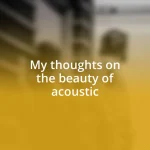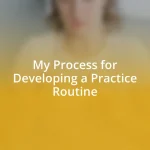Key takeaways:
- Chord progressions are essential for evoking emotions in music, with tension and resolution playing a critical role in engaging listeners.
- A strong understanding of music theory, including scales, intervals, key signatures, and time signatures, provides a foundation for effective composition.
- Experimentation with chord variations and transposing can lead to new emotional depths and creative possibilities in songwriting.

Understanding Chord Progressions
Chord progressions are the backbone of music, guiding the emotional journey of a piece. I remember the first time I stumbled upon the I-IV-V progression; it felt like uncovering a secret code that instantly made my music come alive. Have you ever experienced that moment when a simple sequence of chords just resonates with you? That’s the magic of knowing how chords interact.
As I dove deeper into understanding chord progressions, I realized they aren’t just about rules—they’re about storytelling. Each progression can evoke different feelings; for instance, the somber mood of a minor progression versus the uplifting essence of a major one. When I played a haunting progression on the piano, I could feel the room shift, as if everyone was holding their breath, captivated by the emotions unfolding. Isn’t it fascinating how a few notes can create such a profound impact?
One thing that really struck me is the importance of tension and resolution in chord progressions. When constructing my own music, I found that building up to a surprising chord always made my listeners lean in closer. Why does that happen? It’s because tension pulls us in, and resolution brings everything back to a comforting state—like coming home after a long journey. Understanding this dynamic has transformed how I approach songwriting, making it a deeper emotional experience for both me and my audience.

Fundamentals of Music Theory
The fundamentals of music theory are essential for anyone looking to compose music effectively. At its core, music theory offers a way to understand how different sounds come together to create harmony and melody. When I first delved into concepts like scales and intervals, it was like learning a new language—one that allowed me to express my emotions through music more precisely. Have you ever noticed how each note feels distinct yet contributes to a larger picture? That’s the essence of music theory.
When I learned about major and minor scales, it was a revelation. I remember sitting with my guitar and experimenting with a C major scale, then transitioning to a C minor. The shift in the mood was palpable! Major scales felt bright and joyful, while minor scales brought a sense of melancholy. This experimentation fueled my appreciation for the emotional palette that scales offer. How often do we overlook the simple act of playing different scales? Yet that’s where the magic begins.
Furthermore, understanding key signatures and time signatures has been instrumental for me in organizing my musical ideas. Initially, these concepts seemed daunting, but I soon realized they served as guidelines for my creativity. They provide a framework that prevents me from getting lost in endless possibilities. If you’ve ever been overwhelmed by the sheer scope of musical creation, I promise that familiarizing yourself with these basics can bring clarity.
| Concept | Description |
|---|---|
| Scales | Foundation for melodies; each scale evokes different emotions. |
| Intervals | Distance between notes that creates harmony or tension. |
| Key Signatures | Indicates the key of music and influences the scale used. |
| Time Signatures | Defines the rhythm and structure of a piece. |

Common Chord Progression Types
As I explored common chord progressions, the learning curve felt both exciting and a bit overwhelming. Each type has its own character and emotional weight, significantly impacting the music we create. I recall the first time I strummed the classic I-IV-V progression on my guitar; it felt like opening a door to a room full of possibilities. It’s that familiarity mixed with versatility that makes these progressions so popular among musicians.
Here are some common chord progression types that many find invaluable:
- I-IV-V: This straightforward and uplifting progression is prevalent in folk and rock music.
- ii-V-I: Often used in jazz, this progression creates smooth transitions and lush harmonies.
- I-vi-IV-V: This nostalgic sequence is embraced in pop songs and holds a special place in my heart.
- I-V-vi-iii-IV: Known as the “Axis of Awesome,” this catchy progression showcases emotional depth and is great for ballads.
- I-ii-iii-IV: A bright and playful progression that catches your ear, perfect for cheerful tunes.
Each of these progressions has layers of emotion that can set the tone for an entire piece. I remember how tinkering with the I-V-vi-iii-IV progression inspired me to write a reflective song about personal growth. Finding the right progression is like discovering the perfect key to unlock your creative potential—it can lead you down a path of surprising inspiration!

Creating Emotional Impact with Chords
The emotional impact of chords often strikes me in unexpected ways. I vividly recall the first time I played a D minor chord; it felt like a whisper of sadness that wrapped around me. Isn’t it fascinating how just a simple shift from major to minor can evoke such a profound change in mood? This shift can color a melody, turning joy into introspection with just a flick of the wrist.
There’s something about certain chord combinations that just resonate on a deeper level. For example, when I experimented with the vi-IV-I-V progression, it was as if I was painting with sound. Each chord seemed to tell a story, weaving a tapestry of nostalgia and yearning. Have you ever felt like a chord progression was speaking directly to your heart? Those moments remind me that music is not just a collection of sounds—it’s a way to express complex emotions that words often fail to capture.
In my journey, I’ve learned that dynamics play a crucial role in creating emotional impact with chords. I remember layering soft arpeggios over a gentle strum, and it transformed the entire piece into something ethereal. This delicate balance can turn an ordinary progression into a moving experience. How do you control the ebb and flow of your music? For me, it’s about experimenting and really feeling what each chord conveys, allowing the music to breathe and unfold naturally.

Experimenting with Chord Variations
Experimenting with chord variations can feel like a thrilling adventure. I recall a time when I decided to throw a surprise major seventh into a familiar progression. The sound was so lush and dreamy that it completely transformed the atmosphere, almost like cooking with an unexpected spice—everything suddenly tasted richer. Have you ever stumbled upon a sound that just clicks, making you want to explore it further?
One of my favorite experiments involves altering bass notes beneath chords to create unique feelings. For instance, when I played a C major chord but dropped the bass to A, it introduced a subtle, almost haunting quality. It’s as if each variation allows unfamiliar emotions to surface. Have you ever experienced a rush of inspiration just by changing one note in a progression? It’s remarkable how tiny shifts can lead to significant discoveries.
I also love playing around with extended chords, adding nine or eleven. The first time I incorporated an add9 into an otherwise simple progression, I felt like I was opening up a hidden door in my musical landscape. It added a layer of complexity that made the piece feel more alive. If you haven’t tried this yet, I encourage you to dive in—you may find a new dimension to your music waiting just beneath the surface.

Transposing Chord Progressions
Transposing chord progressions has been a game-changer in my musical practice. I remember the first time I moved a simple G-C-D progression up to A-B-D. It felt like lifting the entire song into a new realm, breathing fresh life into familiar sounds. Have you ever played a song in a different key and felt it take on a whole new energy? It’s amazing how just a simple transposition can alter the vibe entirely.
One thing I love about transposing is how it opens up new possibilities for vocalists. When I shifted a song up a whole step for a friend, her voice soared, reaching notes she usually struggled with. It was like finding the perfect piece of clothing that just fits—you see how much more confident and expressive she became. This reinforces my belief that understanding how to transpose isn’t just a technique; it’s a way to empower those around you.
Often, I find it helpful to visualize the keyboard or fretboard while transposing. When I try to mentally map out the chord shapes in my head, it feels like navigating through an old neighborhood with a fresh perspective. I’ve learned to embrace challenges like figuring out how to quickly shift between keys. Ever found yourself in a situation where your fingers feel clumsy as you adjust? Trust me, that’s a sign of growth—it’s part of the learning curve. Each time I transpose, I not only discover new sounds but also deepen my connection to the music I love.

Applying Progressions in Songwriting
When I dive into songwriting, applying chord progressions is like painting on a blank canvas. Recently, I wrote a song using a classic I-IV-V progression, but I decided to add a minor vi chord in the mix. The contrast was striking; it filled the song with a sense of yearning that pulled at my heartstrings. Have you ever felt that rush of emotions come alive through an unexpected chord?
I’ve also discovered the power of rhythm within chord progressions. One day, while jamming, I played a simple chord sequence but varied the strumming pattern. It transformed the entire song, giving it an infectious groove that made it impossible for me to stay still. Have you ever noticed how rhythm can breathe life into even the simplest of progressions? Sometimes, it’s not just about what chords you play, but how you play them.
Another technique I love is layering progressions to create rich harmonies. Last week, I experimented by stacking vocals over a progression I had written; each layer added a new dimension to the piece. It felt like building a musical wall, each brick contributing to a stronger structure. Have you ever layered your sound and felt it resonate on a deeper level? There’s something profoundly satisfying about hearing your musical ideas evolve and transform into a fuller, more expressive form.















